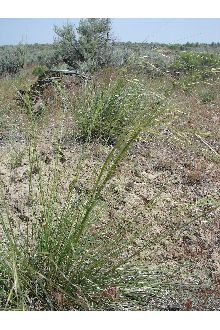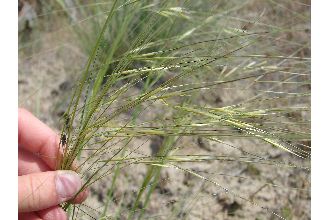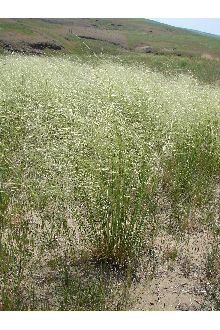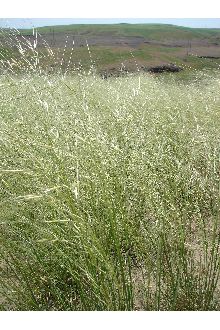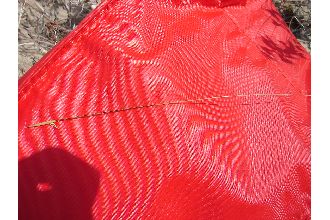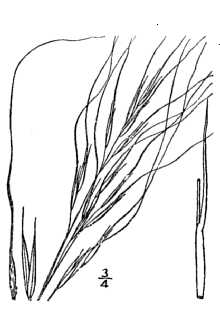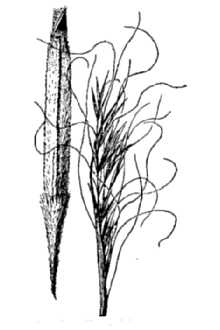Hesperostipa comata (Trin. & Rupr.) Barkworth var. comata
Scientific Name: Hesperostipa comata (Trin. & Rupr.) Barkworth var. comata
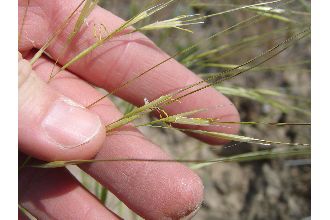
| General Information | |
|---|---|
| Usda Symbol | HECOC9 |
| Group | Monocot |
| Life Cycle | Perennial |
| Growth Habits | Graminoid |
| Native Locations | HECOC9 |
Plant Guide
Use a soil moisture meter to monitor the soil moisture where Hesperostipa comata (Trin. & Rupr.) Barkworth var. comata is planted.
Fact Sheet
Alternate Names
needle & thread grass, needleandthread, Stipa comata
Uses
Needle and thread is grazed readily by all livestock, especially in early spring and late fall. It cures well on the stem and provides good forage in fall and winter.
Status
Please consult the PLANTS Web site and your State Department of Natural Resources for this plant’s current status, such as, state noxious status and wetland indicator values.
Description
Grass Family (Poacae). Needle and thread is a native, cool-season, perennial bunch grass. It ranges in height from 1 to 4 feet. It has narrow basal leaves with the blade usually rolled inward, 3 to 12 inches long. Leaves along the stem are shorter and wider than the basal leaves. The seedhead is an open panicle 5 to 10 inches long that is loosely spreading with 1-flowered spikelets. Each seed is 3/8 inch long. The lemma has a slender awn usually 4 to 5 inches long, sometimes 9 inches. Part of the awn next to the seed is tightly twisted and covered with fine soft hair. The awn tip is rough and usually straight. Distribution: For current distribution, please consult the Plant Profile page for this species on the PLANTS Web site.
Management
Periodic grazing deferments of at least 90 days and proper grazing use allow this grass to make maximum production and keep it in balance with associated grasses. To prevent seed from injuring sheep and contaminating wool, remove sheep for 2 to 3 weeks until seed ripen and fall to the ground. © W.L Wagner Smithsonian Institution-Botany @ plants.usda.gov
Establishment
It grows in the early spring and in the late fall if moisture is available, It produces an abundance of basal leaves, which stay green during most seasons, It reproduces from seed and is primarily adapted to sandy or gravelly loam soils, Use soil moisture sensors to measure the soil moisture of Hesperostipa comata (Trin. & Rupr.) Barkworth var. comata., Cultivars, Improved and Selected Materials (and area of origin) Please contact your local NRCS Field Office,
Plant Traits
Growth Requirements
| Temperature, Minimum (°F) | -38 |
|---|---|
| Adapted to Coarse Textured Soils | Yes |
| Adapted to Fine Textured Soils | No |
| Adapted to Medium Textured Soils | Yes |
| Anaerobic Tolerance | None |
| CaCO3 Tolerance | Medium |
| Cold Stratification Required | Yes |
| Drought Tolerance | High |
| Fertility Requirement | Low |
| Fire Tolerance | High |
| Frost Free Days, Minimum | 130 |
| Hedge Tolerance | None |
| Moisture Use | Low |
| pH, Maximum | 8.4 |
| pH, Minimum | 6.6 |
| Precipitation, Maximum | 20 |
| Precipitation, Minimum | 5 |
| Root Depth, Minimum (inches) | 16 |
| Salinity Tolerance | None |
| Shade Tolerance | Intolerant |
Morphology/Physiology
| After Harvest Regrowth Rate | Slow |
|---|---|
| Toxicity | None |
| Shape and Orientation | Semi-Erect |
| Nitrogen Fixation | None |
| Resprout Ability | No |
| Active Growth Period | Spring |
| Bloat | None |
| C:N Ratio | High |
| Coppice Potential | No |
| Fall Conspicuous | No |
| Fire Resistant | No |
| Flower Color | White |
| Flower Conspicuous | No |
| Foliage Color | Green |
| Foliage Porosity Summer | Dense |
| Foliage Texture | Medium |
| Low Growing Grass | No |
| Lifespan | Moderate |
| Leaf Retention | No |
| Known Allelopath | No |
| Height, Mature (feet) | 3.0 |
| Growth Rate | Moderate |
| Growth Form | Thicket Forming |
| Fruit/Seed Conspicuous | Yes |
| Fruit/Seed Color | White |
| Foliage Porosity Winter | Moderate |
Reproduction
| Vegetative Spread Rate | None |
|---|---|
| Small Grain | No |
| Seedling Vigor | Low |
| Seed Spread Rate | Slow |
| Seed per Pound | 137857 |
| Fruit/Seed Persistence | No |
| Propagated by Tubers | No |
| Propagated by Sprigs | No |
| Propagated by Sod | No |
| Propagated by Seed | Yes |
| Propagated by Corm | No |
| Propagated by Container | No |
| Propagated by Bulb | No |
| Propagated by Bare Root | No |
| Fruit/Seed Period End | Fall |
| Fruit/Seed Period Begin | Summer |
| Fruit/Seed Abundance | Medium |
| Commercial Availability | Routinely Available |
| Bloom Period | Early Summer |
| Propagated by Cuttings | No |
Suitability/Use
| Veneer Product | No |
|---|---|
| Pulpwood Product | No |
| Protein Potential | Medium |
| Post Product | No |
| Palatable Human | No |
| Palatable Graze Animal | High |
| Palatable Browse Animal | Medium |
| Nursery Stock Product | No |
| Naval Store Product | No |
| Lumber Product | No |
| Fodder Product | Yes |
| Christmas Tree Product | No |
| Berry/Nut/Seed Product | No |

